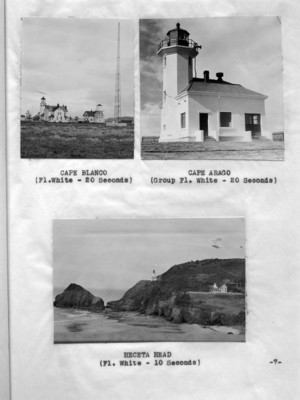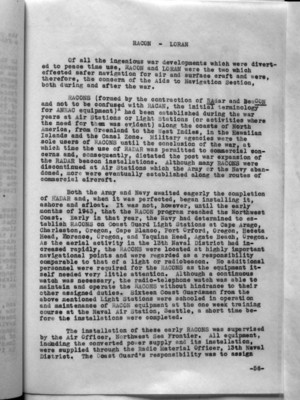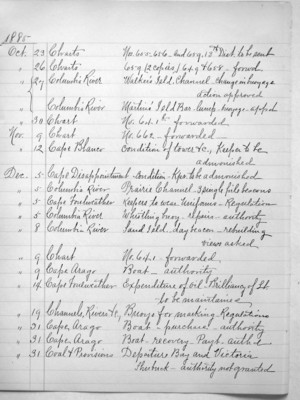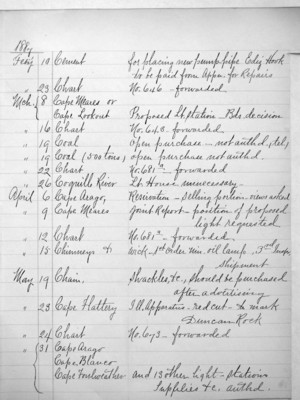Pages That Mention Cape Blanco
Coast Guard District narrative histories 1945
22
to the 350 watt and 750 watt electric lamps of today; this limitation permitted slight variation in the range of the lighted beacons. The lenses increased and magnified the light as they revolved to produce a flashing effect.
Reminicenses of the Lighthouse men who tended these lights during the years when the Northwest was, for the most part, a mountainous wilderness, make interesting listening. Even after the invention of railroads, telephones and the automobile, trips to coastal Light Stations involved travel by boat, stage and horseback. Stage drivers informed passengers before the journey began, that there was no guarantee that the stage could complete the trip, in which event, the traveller made the remainder of his journey on foot. Seasonal rains, washouts, and the miserable conditions of the "roads" (deer trails, or Indian paths) made such stipulations a necessity. Today's brief trip from Bandon to Cape Blanco, Oregon, can be made either way in a fraction of an hour; earlier travellers spent three days; The uncertainty of transportation was illustrated in the following anecdote: An engineer of the Lighthouse Service was called to Destruction Island to repair the boilers. A buoy tender took the engineer to the Island and he requested that the tender return on Friday to pick him up. Friday came - and went; another Friday - no tender; a third Friday - and in the distance the curl of a tender's smoke was seen on the horizon (in those days the smoke trails of the various type ships identified them to the men whose idle hours were spent watching the horizon for the vessels that occasionally appeared there.) When the Master of the tender was admonished for his tardiness, he replied, "You said to come on Friday; isn't this Friday?". Time was of little import.
Life on the Light Stations until the middle thirties was a world of its own. Because of their locations there were no telephone facilities, and commercial electric power did not reach to the outposts. There were generally two keepers and their families assigned to each station and the competition for the most tidy and efficient station among the keepers was keen. A few of the isolated stations at Tillamook Rock, Destruction Island, Cape Flattery, etc. had four or five keepers, one on continuous liberty rotation. With the installation of radiobeacons at many of the stations, it became necessary to bring in commercial electric power or generate power at the station. With electricity available, the i.c.v. light was superceded, the fog signals mechanized, and the comforts of the keeper's dwellings increased. Telephone service or radio-telephone service soon followed as
26
(Image top left)
CAPE BLANCO (Fl.White - 20 Seconds
(Image top right) CAPE ARAGO (Group Fl. White - 20 Seconds)
(Image bottom) HECETA HEAD (Fl. White - 10 Seconds)
76
Of all the ingenious war developments which were diverted to peace time use, RACON and LORAN were the two which effected safer navigation for air and surface craft and were, therefore, the concern of the Aids to Navigation Section, both during and after the war.
RACONS (formed by the contraction of RAdar and BeaCON and not to be confused with RACAN, the initial terminology for ANRAC equipment)¹ had been established during the war years at Air Stations or Light Stations (or activities where the need for them was evident) along the coasts of North America, from Greenland to the West Indies, in the Hawaiian Islands and the Canal Zone. Military agencies were the sole users of RACONS until the conclusion of the war, at which time the use of RADAR was permitted to commercial concerns and, consequently, dictated the post war expansion of the RADAR beacon installations. Although many RACONS were discontinued at Air Stations which the Army or the Navy abandoned, more were eventually established along the routes of commercial aircraft.
Both the Army and Navy awaited eagerly the completion of RADAR and, when it was perfected, began installing it, ashore and afloat. It was not, however, until the early months of 1943, that the RACON program reached the Northwest Coast. Early in that year, the Navy had determined to establish RACONS on Coast Guard Light Stations at Cape Arago, Charleston, Oregon, Cape Blanco, Port Orford, Oregon, heceta Head, Florence, Oregon, and Yaquina Head, Agate Beach, Oregon. As the aerial activity in the 13th Naval District had increased rapidly, the RACONS were located at highly important navigational points and were regarded as a responsibility comparable to that of a light or radiobeacon. No additional personnel were required for the RACONS as the equipment itself needed very little attention. Although a continuous watch was necessary, the radio-telephone watch was able to maintain and operated the RACONS without hindrance to their other assigned duties. Sixteen Coast Guardsmen from the above mentioned Light Stations were schooled in operation and maintenance of RACON equipment at the one week training course at the Naval Air Station, Seattle, a short time before the installations were completed.
The installation of these early RACONS was supervised by the Air Officer, Northwest Sea Frontier. All equipment, including the converted power supply and its installation, were supplied through the Radio Material Officer, 13th Naval District. The Coast Guard's responsibility was to assign
-56-
Box 252 List of supplies 1885, YB, YH Emery Pay 1887
2
1885
Oct. 23 Charts Nos. 655_656_and 659, 13th Dist. to be sent Oct. 26 Charts 659 [2 copies] 649 & 658 - forwd. Oct. 27 Columbia River Walker's Isld. Channel_change in buoyage action approved Oct. 27 Columbia River Martins' Isld Bar - lump - buoyage - ??? Oct. 30 Chart No. 641 ??? forwarded Nov. 9 Chart No. 662_forwarded_ Nov. 12 Cape Blanco condition of tower &c., Keeper to be admonished Dec. 5 Cape Disappointment - Condition - Kper. to be admonished Dec. 5 Columbia River Prairie Channel-3 single pile beacons Dec. 5 Cape Foulweather Keepers to wear Uniforms _ Regulation Dec. 5 Columbia River Whistling buoy - repairs - authority Dec. 8 Columbia River Land Isld. - day beacon - rebuilding views asked Dec. 9 Chart No. 641 - forwarded Dec. 9 Cape Arago Boat_authority Dec. 14 Cape Foulweather Expenditure of oil - Brilliancy of Lt. - to be maintained Dec. 19 Channels, Rivers &c., Buoys for marking_Regulations Dec. 31 Cape Arago Boat - purchase - authority Dec. 31 Cape Arago - Boat - recovery - Payt - authd. Dec. 31 Coal & Provisions Departure Bay and Victoria Shubuck - authority not granted
3
1887
Feby 10 Cement for placing new pump-pipe Ediz Hook to be paid from Appr. for Repairs Feby 23 Chart No. 646 - forwarded Mch. 8 Cape Meares or Cape Lookout Proposed Lt. station_Bds. decision Mch. 16 Chart No. 648 - forwarded Mch. 19 Coal open purchase - not authd., tel., Mch. 19 Coal (500 tons) open purchase not authd. Mch. 22 Chart No. 681a _ forwarded Mch. 26 Coquille River Lt. House unnecessary - April 6 Cape Arago, Reservation - selling portion - views asked April 9 Cape Meares Joint Report- position of proposed light requested April 12 Chart No. 681a _ forwarded April 15 Chimneys & wick - 1st Order Min. oil lamp, 3rd Insp, shipment May 29 Chain. shackles, &c, should be purchased after advertising May 23 Cape Flattery Ill. Apparatus - red cut - to mark Duncan Rock May 24 Chart No. 673 _ forwarded May 31 Cape Arago Cape Blanco Cape Foulweather and 13 other light-stations Supplies &c. authd.




